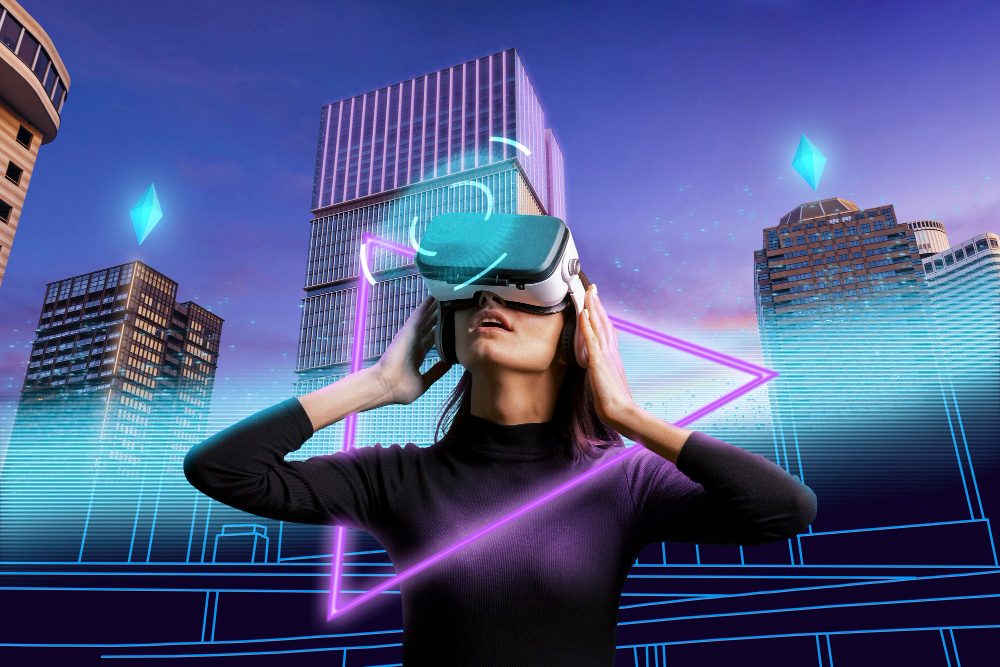Hey there, let’s talk about something super cool: augmented reality, or AR for short. It’s like a magical twist on the real world, where digital stuff mixes with the stuff you can touch and see every day.
Imagine this: You’re looking at your phone, and suddenly, your face changes into a funny animal on the screen. That’s AR! Or maybe you’ve played a game where you catch virtual creatures that pop up in the real world around you, like Pokemon Go. Yep, that’s AR too!
But wait, what about those fancy VR headsets like Oculus Rift? Well, hold on a sec, that’s something else called virtual reality, and we’ll chat about that later.
Now, AR isn’t just for goofy selfies or catching Pokemon. It’s a technology that helps people in some pretty amazing ways. Think about fighter pilots who fly incredibly fast planes. AR helps them stay safe and do their jobs better. And it’s not just pilots – even surgeons use AR to do really complicated surgeries!

But you know what’s even more fascinating? AR didn’t start out this fancy and easy to use. It’s come a long way, and we’re going to dive into its awesome journey. So, stick around, and let’s explore the world of augmented reality together!
Let’s dive into the fascinating history of Augmented Reality (AR) in a way that’s easy to understand.
AR was first brought to life back in 1968 by a smart guy named Ivan Sutherland, who worked at Harvard University. He made something called a “head-mounted display,” which was like a special pair of glasses, but it was huge and heavy! In fact, it was so heavy that they had to attach it to the ceiling so people could use it.
For a long time, AR was mainly used by pilots, soldiers, and people in factories to practice and learn things. But it didn’t become something lots of people knew about until the late 1990s.
Now, here’s a fun fact: one of the first times many of us saw AR was during football games on TV! You know that yellow line they show on the field to mark where the players need to go to get a first down? That’s AR! It helps us understand the game better.
After that, AR started growing really fast. Between 2011 and 2013, big companies like Disney, Coca-Cola, and National Geographic used AR for things like cool events and showing off in places like malls and Times Square.
Then, in 2014, Google did something really cool. They made something called Google Glass. It was like a pair of glasses you could wear, and it showed you digital stuff right in front of your eyes. All you had to do was nod your head! It was like magic.
And remember Snapchat? They added something called “geofilters” not long after that. It let you add cool pictures to your photos based on where you were. Then, they made “Lenses” which could change your face in funny ways in photos and videos.
A lot of people loved using Snapchat for AR stuff. By the end of 2017, 187 million people were using it every day! And that’s just one app. Now, AR is everywhere. Social media, businesses, and even stores use it. It’s become super popular, and it’s all about adding a touch of digital magic to our world.
How Augmented Reality Works: A Simple Explanation
Ever wondered how those cool augmented reality (AR) apps and devices work? Well, I’m here to break it down for you in a super easy way.
Step 1: Cameras and Sensors
So, the magic of AR begins with something we all know – cameras and sensors. Imagine you have a pair of super-smart glasses or a fancy AR app on your phone. These devices use their built-in cameras and sensors to see and understand what’s happening around you. It’s like they’re the eyes and ears of the AR world.
For example, your smartphone has a camera that takes pictures, right? Well, AR apps use that camera to capture what’s in front of you – your real surroundings. But not just any camera will do the trick. Some cameras, like the one on the iPhone X, can see things in 3D, which makes the AR experience more real and amazing.

Step 2: Processing Power
Now, here’s where the tech stuff kicks in. AR isn’t just about looking cool; it’s about making sense of what the cameras and sensors see. Imagine you’re playing an AR game where digital creatures pop up in your living room. Your device needs some serious brainpower to figure out how you’re moving, tilting, and where those digital creatures should appear.
Good news – most of our smartphones are pretty smart themselves these days. They have enough brainpower to do all this without needing extra hardware. But it wasn’t always this way. Google had to work hard to make those cameras and sensors fit into our phones without making them huge and clunky.
Step 3: Projection
Now comes the fun part! After your device has captured info about the real world and processed it, it’s time to bring in the digital stuff. This is where projection comes in. Think of it like your device’s way of saying, “Hey, let’s put some cool digital things right here in your world.”
Right now, most AR devices show those digital things on a screen, like your phone’s screen or the screens in fancy AR glasses. But guess what? In the future, we might not even need screens. Some super advanced AR tech can project digital stuff directly onto surfaces. So, you could have a virtual pet running around your table without wearing any headset or staring at a screen.
And there you have it! That’s how augmented reality works in a nutshell. It’s all about using cameras and sensors to understand your world, some fancy processing to make it interactive, and cool projection to bring the digital into your real life. As technology keeps advancing, we can expect even more amazing AR experiences in the future. So, get ready to be amazed by the wonders of augmented reality!
Different Kinds of Augmented Reality (AR)
You know, there are lots of different types of augmented reality, and they’re like different tools for different jobs. Let me break it down for you in a friendly and easy-to-understand way.
1. Marker-based AR (Image Recognition AR)
Imagine you have a special “cue” like a QR code or a picture on a cereal box. When you point your AR device at it, it shows you something cool. It’s like magic! This one doesn’t need much computer power, but it only works when you have those special triggers.
Example: Think about IKEA’s app. You can use it to see how furniture would look in your home before you buy it.
2. Markerless AR
This AR is even more versatile. It doesn’t need special triggers. Instead, it uses things like cameras, GPS, and sensors to figure out where you are and show you useful stuff. It’s like a smart AR that knows where you are!
Example: Remember IKEA? Yep, they use this too. You can see their furniture in your room without any special codes.
3. Projection-based AR
Picture this – AR that projects digital pictures right onto things around you. For instance, you can make a virtual keyboard appear on your desk. It’s like turning everyday objects into screens! But this one isn’t always practical for small stuff.
4. Outlining AR
This one is easy to understand. It’s like drawing lines around things using AR. It helps drivers see the road’s edges when it’s dark and helps pilots land safely by showing them where the runway is.
5, Superimposition AR
This AR is like a doctor’s secret tool. It can replace a real thing with a digital image. For example, during surgery, a doctor can use AR to put a digital X-ray over a patient’s body. It’s like magic, but for doctors!
Each type of AR has its own special superpowers and things it’s good at. So, when you’re using AR, think about which type is the best fit for the job you want to do!
Imagine you have two cool tech things: AR and VR. They’re kinda similar, but they work differently.
Virtual Reality (VR) is like putting on special goggles that take you to a whole new make-believe world. Everything you see and feel is just in your imagination. It’s fun, but it’s not great for everyday stuff, and you might bump into things if you’re not careful.
Now, Augmented Reality (AR) is more like having a secret helper. It adds digital stuff to the real world around you. So, you can use it for all sorts of things in your daily life, not just for games or pretend stuff. AR is pretty handy!
Augmented Reality (AR) Apps and Fun Examples
Ever heard of augmented reality? It’s like a super cool tech trick that does more than just putting funny flower crowns on your head or catching Pokemon. It’s super versatile and can be used for all sorts of things.
Let’s chat about some of the awesome ways people use augmented reality, and I’ll give you some examples.
Traveling
So, when I travel, I want a few basic things on my flights, like good food, free drinks, movies to watch, some free luggage, Wi-Fi, live TV, comfy lounges, and pilots who know how to fly. Augmented reality is making a difference in at least one of these things.
Companies like Aero Glass have made these cool AR glasses for pilots. These glasses show them the airport, the city, navigation points, and even other planes. This helps pilots fly safely, even when it’s cloudy or foggy outside.

But wait, there’s more! AR isn’t just for flying; it’s also changing how we drive. You know, most of us spend over 12 days each year driving. Tools like WayRay’s Navion make driving awesome by showing directions right on your car’s windshield.
And guess what? You can even use hand gestures to control stuff, so you don’t have to fiddle with your phone while driving. This makes driving safer because you’ll be looking at the road more and less at your gadgets.
Retail
Have you ever heard of augmented reality? It’s like magic for your phone. It won’t put together your IKEA furniture, but it can help you choose the perfect table for your dining room.
IKEA has this cool app called “IKEA Place.” With it, you can see more than 2,000 pieces of furniture in your own home before you buy them. It’s like trying them out without leaving your house! And it’s not just for furniture – even architects and engineers use augmented reality to check out building stuff like materials and layouts before they make decisions.
Oh, and if you love makeup, there’s an app called Sephora’s Virtual Artist. You can try on all sorts of makeup on your photos. They even have makeup styles made by Sephora experts and fun tutorials to show you how to use makeup like a pro.
These apps make it super easy for you to make smart buying choices. You don’t even have to leave your comfy couch!
Education
Education can get super exciting with something called augmented reality, which is like mixing real life with computer magic. Imagine your boring old textbooks and classrooms becoming like a cool video game. You know those pictures in your books that just sit there? Well, with augmented reality, they can come alive!
For example, if you’re studying rocks and stuff (geology), instead of just looking at pictures, you can use augmented reality to explore a volcano from the inside. It’s like going on an adventure without leaving your classroom!
Even simple stuff like flashcards can get a makeover with augmented reality. There are cool apps, like AR Flashcards Animal Alphabet, that make learning the ABCs way more fun. When you’re studying the letter “P,” a cute penguin can pop up and say hi to you. Learning becomes a fun game!
So, augmented reality is like a magic tool that makes learning awesome and exciting. It turns boring stuff into super cool adventures, and that’s a win for everyone in the classroom.
Marketing
Marketing with augmented reality (AR). Imagine a world where you can try out stuff before buying it, like magic! Big companies like IKEA, TopShop, and Converse are doing just that. They use AR to let you see how their stuff looks on you, without even leaving your home. It’s like trying on clothes or furniture in a snap!
But wait, there’s more. AR is not just for trying stuff. It’s also used in ads to amaze people. Think about Pepsi. They did something crazy in London. They put cameras in a bus stop and showed crazy things like UFOs, robots, balloons, and a wild tiger! People thought it was all happening right there on the street.
Guess what? People loved it! They watched a video of it on YouTube over 6 million times. That’s like super popular on the internet. So, AR can make marketing fun and exciting, and everyone loves it!
Healthcare
Let’s talk about how cool Augmented Reality (AR) can be in the healthcare world. Imagine you’re a medical student or a doctor, and you want to learn or practice medical stuff. AR can help you with that. But it’s not just about saving lives.
There’s this company in New York called AccuVein. They use AR to make life easier for nurses. When nurses need to put those IV needles in your veins, it can be tricky. But with AR, they can see your veins better and do it more successfully. That’s a big win for both nurses and patients, making IVs work 350% better!
AR can also help people who can’t see well. There’s a company called NuEyes that makes special glasses with AR magic. These glasses can help kids who can’t see very well read and recognize their friends. Imagine that!
And here’s something amazing: AR can even help folks who’ve lost a limb. You know that feeling when your missing arm or leg hurts even though it’s not there? It’s called phantom limb pain, and it’s awful. But AR can make it better. Scientists use AR to show a digital limb to the patient. It tricks their brain into thinking their missing limb is back. With some special electrodes, patients can practice making the digital limb relax, and it helps ease their pain. AR is like a superhero for healthcare!
How Small Businesses Can Benefit from Augmented Reality (AR)
I want to talk to you about how small businesses, like your local shops or cafes, can use Augmented Reality (AR) to grow and make customers happy.
You know how big companies like IKEA and Wayfair let you see furniture in your home before you buy it? Well, that’s AR in action! Even The New York Times is trying cool stuff with AR for news stories, and Starbucks is creating fun AR experiences in their coffee shops.
But guess what? Small businesses can also use AR without needing to be computer experts. According to HubSpot Research, some businesses teamed up with Pokémon GO and turned their shops into special spots for the game. This brought in more people, and they made about $2,000 extra in sales every week. That’s pretty amazing, right?
So, if you’re growing your small business, keep an eye out for ways to partner with AR experiences that already exist. It doesn’t have to be expensive! And if you want to make your very own AR thing, here’s a tip: start by thinking about your customers and what they like.
Sure, any company can make an AR app, but not all of them will make customers happy. AR should help your customers connect with your brand in a way that makes them want to buy from you. For example, if you sell stuff, let people use AR to see how it would look or work in their own homes.
Now, if you’re thinking about AR versus VR (Virtual Reality), we suggest going with AR. VR needs special and pricey equipment that not everyone has. But almost everyone has a smartphone, and that’s all you need for AR!
So, if you have a good idea and some tech skills, trying out AR for your business could be a smart move. It’s a cool way to grow and make your customers smile!
Conclusion
The world of augmented reality (AR) is a fascinating and rapidly evolving realm where digital magic blends seamlessly with our everyday lives. From goofy selfies and entertaining games like Pokemon Go to aiding fighter pilots and surgeons in their critical tasks, AR has come a long way since its inception.
The history of AR, dating back to Ivan Sutherland’s pioneering work in 1968, highlights its gradual transformation into a versatile and accessible technology. From football broadcasts to Google Glass, AR has found its way into various aspects of our lives.
Understanding how AR works involves cameras and sensors capturing real-world surroundings, powerful processing to interpret data, and projection to seamlessly integrate digital elements into our environment. As technology advances, the possibilities for AR continue to expand, promising even more incredible experiences in the future.
There are different types of AR, each tailored for specific purposes. Marker-based AR, markerless AR, projection-based AR, outlining AR, and superimposition AR all have unique applications, making AR a versatile tool in various fields.
Comparing AR with virtual reality (VR), AR stands out as a more practical and accessible option, enhancing our real-world experiences rather than immersing us in entirely virtual environments.
Moreover, AR has found applications in travel, retail, education, marketing, and healthcare. It assists pilots, drivers, shoppers, students, marketers, and healthcare professionals in numerous ways, making tasks more efficient and engaging.
Even small businesses can benefit from AR, as demonstrated by examples of increased sales and customer engagement through creative AR partnerships and customer-centric AR experiences.
In essence, augmented reality is a transformative technology that continues to shape our world in exciting and practical ways. It enriches our experiences, simplifies complex tasks, and offers new avenues for businesses to connect with their customers. As AR technology continues to advance, its impact on our lives is bound to grow, promising even more fantastic applications in the years to come.







